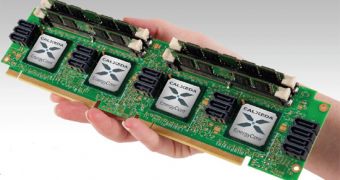As ARM begins making chips usable in servers, even the big players on the server and data center markets are showing interest in the possibility of adopting them instead of x86 chips.
Intel's x86 architecture has basically been, for a long time, the holder of a monopoly, of sorts, over servers, data centers and whatever other large-scale data storage systems exist.
Now, though, 64-bit ARM-based server chips are known to be viable, and Calxeda even created the world's first ARM-based server CPU.
Normally, this wouldn't be too big an issue for Intel, not an immediate one at least.
Hearing HP saying that it had fully decided to use a new architecture based on those very Calxeda chips won't be so easily shrugged off as irrelevant though.
Apparently, the x86 CPUs of today are just a bit too powerful, or at least unnecessarily mighty, for what Internet and workloads exist right now.
The fact that the applications they run aren't, for the most part, specifically written for the x86 architecture is convenient as well.
Basically, the power efficiency advantages and the need to explore more space-efficient server designs was enough to turn HP into the first major endorser of ultra low-power ARM server designs.
“Despite ever-more-powerful CPUs, and the benefits and maturity that come from commoditization, x86 server development has essentially stagnated over the past 10 years,” said John Abbott, chief analyst at 451 Research.
“HP's 'Moonshot Architecture' represents a multiyear effort to establish a more efficient breed of extreme low-energy servers for hyper-scale use cases – such as large-scale Web, social media, content delivery, financial services, scalable analytics and 'big data' uses.”
The first of HP's servers to use Calxeda's ARM-based EnergyCore server CPU is called ProLiant SL 'Redstone' and will be turned on in the first half of next year (2012).

 14 DAY TRIAL //
14 DAY TRIAL //